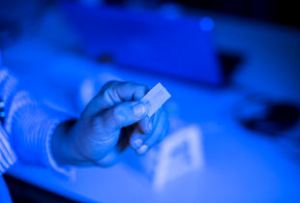Sep 24 2013
Imagine being able to continuallThe sensor design y monitor patients’ vital signs, such as their heart rate, blood oxygen levels and temperature without having to hook them up to a machine? Thanks to the development of exciting new smart sensor technology, researchers at LJMU's Built Environment and Sustainable Technologies (BEST) Research Institute are close to making this a reality.
 The sensor design
The sensor design
Researchers Professor Ahmed Al-Shamma’a, Dr Andrew Shaw, Dr Alex Mason and Stephen Wylie have invented new electromagnetic wave sensors that can now be woven into any fabric and incorporated into any garment.
Invisible and undetectable to the wearer, these non-invasive sensors are sensitive enough to pick up a wide range of vital signs and can transmit these readings in real time to devices located many metres away.
The sensor design - plus garments and wristbands incorporating this exciting new technology - has just been published as the 2.5mth patent application (GB2500000) by the UK Intellectual Property Office.
Professor Al-Shamma’a said: “While we are still in the early stages of development, the range of potential applications for this wearable sensor technology is immense, not just in the health care sector but also in sporting and military applications.
“The traditional hospital identity bracelet, for example, could eventually be adapted to include this sensor technology. Garments could also be developed for people with dementia living in the community, giving care workers a non-invasive way of monitoring their health and wellbeing. A key area for this technology is to support patients in the community with long term conditions such as congestive heart failure, COPD and Diabetes etc and reduce the number of unplanned hospital admissions and emergency interventions.
“Ultimately, whether worn in the hospital or at home, this technology could represent significant potential cost saving advantages for the NHS and could also improve patient care.”
Minister for Intellectual Property, Lord Younger said: “This new technology demonstrates the importance of collaboration, and the wealth of knowledge transfer taking place, between our world class Universities and UK companies.
“The history of patents is a great Professor Ahmed Al-Shamma’a and Dr Alex Masonway to understand the UK’s inventive spirit and how our industry has developed. From the introduction of the steam locomotive in the 1800s, to TV in the early 1900s, new ideas have changed the way we go about our daily lives and patents provide a great history of our entrepreneurial spirit and industrial development.
“As Minister for Intellectual Property, I am pleased to mark this momentous occasion today and look forward to seeing some of the other inventions from the 22,000 patent applications the IPO review and process every year.”
LJMU is already working with a number of commercial businesses to investigate routes to market and the best way to turn this novel research into commercially viable products - in particular with commercial partner Med ePad.
Med ePad is an innovative mobile health company who staff have over 20 years’ experience of working with the National Health Service, and is working closely with the NHS introduce the use of tablets and other devices to display patient data.
John Hopkins, CEO from Med ePad said: “Being able to analyse and display the data being transmitted by LJMU’s sensors is vital if they are going to have any impact on patient care. That’s where Med epad can help and we are delighted to be working with the University as they investigate how best to harness their research. The opportunities to integrate wireless sensor technology into the management and alerting functions of patients monitoring systems such as Med eTrax will radically alter the way patient are managed in hospital and at home”
All of the inventors work as part of LJMU's BEST Research Institute, which has developed sensors for various applications in the recent years, in areas as diverse as water toxicity sensing through to drug sensing and other non-invasive biomedical sensors. They have also developed sensors to test the purity and constituents of different substances, including olive oil (for a major supermarket) and are collaborating with a public transport company to look at emission monitoring.
The patent application was supported by the LJMU Research & Innovation Services (RIS).
Emma Nolan, IP & Commercialisation Manager said: “We are delighted that this important patent application has published with a notable number, and very excited about the commercial potential for this technology.”
Professor Andy Young, Director of RIS said: “An important part of the remit of RIS is to support University research from early stage ideas through to collaboration with industry, and ultimately to market. By supporting researchers’ right across the University, we aim to bring about demonstrable impact through commercialisation of the University’s intellectual property.”
Med ePad was introduced to Professor Al-Shamma’a by the University’s Open Labs team, whose remit is to match talented small technology businesses with LJMU researchers.
Jason Taylor from Open Labs said: “SMEs typically understand that their businesses would benefit from a productive association with universities but generally lack the resources to find the right academic and to develop and maintain a successful relationship. Supported with funds from the European Regional Development Fund (ERDF), Open Labs support business-university collaborations that deliver innovative new products and services with the potential for global impact.”